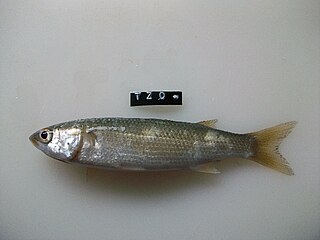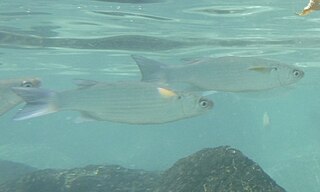Francis Buchanan, later known as Francis Hamilton but often referred to as Francis Buchanan-Hamilton, was a Scottish surgeon, surveyor and botanist who made significant contributions as a geographer and zoologist while living in India. He did not assume the name of Hamilton until three years after his retirement from India.

The South African mullet, also called a harder mullet or simply harder, is a species of mullet. It is found in South African coastal waters from Walvis Bay (Namibia) to KwaZulu-Natal, and grows to a maximum length of 40.5 cm (15.9 in). The person the specific name honours was not recorded by Andrew Smith when he described this species but it is most likely to be John Richardson (1787-1865), the Scottish naturalist, surgeon and Arctic explorer.

Crenimugil is a genus of mullets found in coastal marine waters and rivers in the Indo-Pacific region.

The bobo mullet, is a species of ray-finned fish of the mullet family Mugilidae. It is the only species in the genus Joturus, one of 17 mullet genera containing altogether about 80 species of ray-finned fish. It occurs in rivers, including brackish waters, in much of the Gulf of Mexico basin from Mexico as far south as Panama and the Caribbean coast of Colombia, as well as the West Indies and the United States state of Florida. The specific name honours the Cuban lexicographer and geographer Esteban Pichardo (1799-1879).

Agonostomus telfairii is a species of ray-finned fish in the family Mugilidae, the mullets. It is known by the common name fairy mullet. It is native to the islands off the eastern coast of Africa, where it can be found in freshwater bodies and estuaries in Comoros, Madagascar, Mauritius, Mayotte, and Réunion. It returns to the sea to spawn.

The spiny red gurnard is a species of marine ray-finned fish belonging to the family Triglidae, the gurnards and sea robins. This species is found in the northwestern Pacific Ocean where they occur at depths of from 25 to 615 metres. This species grows to a length of 40 centimetres (16 in) TL. This species is of commercial importance as a food fish.

Mugil thoburni, Thoburn's mullet, is a species of grey mullet, from the family Mugilidae, found in the eastern Pacific Ocean. It is most common around the Galapagos Islands but does occur on the coasts of Central America and South America as well. This species grows to a length of 29.5 centimetres (11.6 in) TL. It was formerly regarded as the only known member of the genus Xenomugil.

Bembras is a genus of marine ray-finned fish belonging to the family Bembridae, the deepwater flatheads. These fishes are found in the Indian Ocean and the western Pacific Ocean.
Brachybembras is monotypic genus of marine ray-finned fish belonging to the family Bembridae, the deepwater flatheads. Its only species, Brachybembras aschemeieri, is known only from the Pacific Ocean around the Philippines where it is found at a depth of around 582 metres (1,909 ft).

Parabembras is a genus of marine ray-finned fish belonging to the family Bembridae, the deepwater flatheads, although they are sufficiently different from the other genera in that family to be classified as their own family, Parabembradidae, by some authorities. These fishes are found in the Indian Ocean and the western Pacific Ocean.
Acropoma lecorneti is a species of ray-finned fish, a lanternbelly from the family Acropomatidae. It is found in the western Pacific Ocean where it has been recorded off Japan and New Caledonia. This species was first formally described by the French ichthyologist Pierre Fourmanoir (1924-2007) with the type locality given as north of the St Vincent Pass off the western coast of New Caledonia at a depth of 360 metres (1,180 ft). The specific name honours the skipper of the fishing boat Thalassa, Monsieur Lecornet, who took the type aboard that vessel.
Agonostomus catalai, the Comoro mullet, is a species of ray-finned fish, a mullet from the family Mugilidae. It is found in the Comoros and Madagascar where it is found in boulder strewn clear, fast flowing rivers, it may also occur in estuaries, It is eaten in Madagascar. The specific name honours René Catala (1901-1988) who was a coffee planter and biologist who collected type in Madagascar. It lays non adhesive, floating eggs.
The Diassanga mullet is a species of ray-finned fish, grey mullet from the family Mugilidae. It is found in the eastern Atlantic around the coasts of West Africa.

The grooved mullet is a species of ray-finned fish, a grey mullet from the family Mugilidae. It is found in the coastal waters of the eastern Atlantic Ocean off the western coast of Africa, as far north as Mauritania, and into the western Indian Ocean.
The pinkeye mullet, also known simply as pinkeye, or freshwater mullet, Richmond mullet, or river mullet, is a species of ray-finned fish from the grey mullet family Mugilidae and the only species in the genus Trachystoma. It is endemic to northeastern Australia where it occurs from the Burnett River in Queensland to the Clyde River in New South Wales. It is a subtropical species which is found in deep, slow flowing sections of rivers as well as in estuaries although it moves into coastal seas to spawn. It feeds mainly on algae and plant material, as well as detritus and benthic invertebrates.

The Burmese mullet is a species of freshwater ray-finned fish, a mullet belonging to the family Mugilidae. It is the only species in the genus Sicamugil. It is found in the drainage systems of the Sittang and Irrawaddy rivers in Myanmar.

Crenimugil heterocheilos, the half fringelip mullet, is a species of ray-finned fish in the family Mugilidae. It is found throughout the Indo-Pacific Ocean.
Pterygotrigla multiocellata, the antrorse spined gurnard, is a species of ray-finned fish belonging to the family Triglidae, the gurnards and sea robins. This fish is found in the Indo-Pacific region where it has been recorded from Japan, Saipan, and the eastern and western tropical waters off Australia.
Pseudochromis ransonneti, the Karimunjawa dottyback, is a species of ray-finned fish in the family Pseudochromidae. It is found in the western Pacific Ocean.

Pseudochromis moorei, the jaguar dottyback, is a species of ray-finned fish in the family Pseudochromidae, It is found in the western-central Pacific Ocean.












